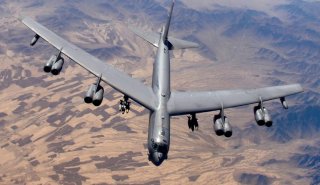Air Force Carries Out Bomber Rotation Over Europe and the Middle East
The U.S. Air Force likely intended to send a message to Moscow and Tehran.
Four Cold War-era B-52 Stratofortress bombers have been deployed back to the United Kingdom after logging considerable miles over Europe and the Middle East last week. The aircraft, support equipment, and personnel from the 5th Bomb Wing of Minot Air Force Base arrived at Royal Air Force (RAF) Fairford on February 10. The U.S. Air Force personnel executed a long-planned Bomber Task Force mission as part of a regularly scheduled U.S. European Command and U.S. Strategic Command joint mission series.
While heading to RAF Fairford, the U.S. bombers integrated with British Typhoon aircraft and Portuguese F-16s that are currently assigned to NATO's Icelandic Air Policing mission. In addition, the B-52s—with call signs HATE 11, HATE 12, HATE 13, and HATE 14—integrated with British Joint Terminal Attack Controllers to conduct bilateral close air support training. The mission focused on enhancing readiness and interoperability for the controllers responsible for coordinating air strikes to support ground forces.
"With an ever-changing global security environment, it’s critical that our efforts with our allies and partners are unified," said Gen. Jeff Harrigian, Commander of United States Air Forces in Europe and Air Forces Africa. "We're in Europe training and collaborating together, because consistent integration is how we strengthen our collective airpower."
Through their rotation, the bombers will operate from RAF Fairford to continue integrating with partners and allies, the U.S. Air Force announced. Such bomber rotations, which have occurred regularly throughout Europe since 2018, maintain readiness and further reinforce the United States’ commitment to NATO allies and coalition partners.
According to media reports, one of the bombers took off from RAF Fairford on Sunday, flew south into the English Channel, and looped past Portugal and Gibraltar before entering the Mediterranean Sea in the early hours of Monday morning. It then traveled up the east coast of Spain before flying over Cornwall and then back to Fairford.
Two of the other bombers reportedly flew south to the Mediterranean and then east toward the Middle East. In addition to serving as a deterrent to Russia's buildup along the Ukrainian border, the deployment was likely intended to send a message to Tehran as well.
The Times of Israel reported that Israeli F-15 fighter jets escorted one of the American B-52 bombers as it made its way through Israeli airspace en route to the Persian Gulf on Monday. The Israeli escort was an apparent show of force to Iran amid lingering tensions in the region.
"The flight was held as part of close cooperation with the US military, which represents a significant element in ensuring the security of the State of Israel's airspace and the Middle East," the Israel Defense Forces said in a statement.
Despite the fact that the B-52 bombers are older than the crews flying the Cold War-era aircraft, the B-52 remains the largest aircraft of its kind in the United States’ arsenal. The warplanes can carry up to 70,000 pounds of weapons, including nuclear warheads, and have a combat range of nearly 9,000 miles. These capabilities should serve as a strong deterrent to any potential adversary.
Peter Suciu is a Michigan-based writer who has contributed to more than four dozen magazines, newspapers and websites. He regularly writes about military small arms, and is the author of several books on military headgear including A Gallery of Military Headdress, which is available on Amazon.com.
Image: Reuters.

